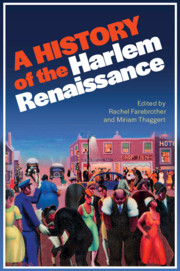Book contents
- A History of the Harlem Renaissance
- A History of the Harlem Renaissance
- Copyright page
- Dedication
- Contents
- Illustrations
- Contributors
- Acknowledgments
- Introduction: Revising a Renaissance
- Part I Re-reading the New Negro
- Chapter 1 Cultural Nationalism and Cosmopolitanism in the Harlem Renaissance
- Chapter 2 Making the Slave Anew: History and the Archive in New Negro Renaissance Poetry
- Chapter 3 The New Negro among White Modernists
- Chapter 4 The Bildungsroman in the Harlem Renaissance
- Chapter 5 The Visual Image in New Negro Renaissance Print Culture
- Part II Experimenting with the New Negro
- Part III Re-mapping the New Negro
- Part IV Performing the New Negro
- Bibliography
- Index
Chapter 5 - The Visual Image in New Negro Renaissance Print Culture
from Part I - Re-reading the New Negro
Published online by Cambridge University Press: 20 January 2021
- A History of the Harlem Renaissance
- A History of the Harlem Renaissance
- Copyright page
- Dedication
- Contents
- Illustrations
- Contributors
- Acknowledgments
- Introduction: Revising a Renaissance
- Part I Re-reading the New Negro
- Chapter 1 Cultural Nationalism and Cosmopolitanism in the Harlem Renaissance
- Chapter 2 Making the Slave Anew: History and the Archive in New Negro Renaissance Poetry
- Chapter 3 The New Negro among White Modernists
- Chapter 4 The Bildungsroman in the Harlem Renaissance
- Chapter 5 The Visual Image in New Negro Renaissance Print Culture
- Part II Experimenting with the New Negro
- Part III Re-mapping the New Negro
- Part IV Performing the New Negro
- Bibliography
- Index
Summary
Goeser explores the work of visual artists, who worked alongside writers, cultural leaders, editors, and publishers to animate the pages and covers of journals, little magazines, and books with graphic images. She identifies the strategies of Aaron Douglas, Gwendolyn Bennett, Richard Bruce Nugent, and many others, to radically re-picture Black American identity – to make Black modern. Goeser argues that by providing visual components integral to Harlem Renaissance texts, Douglas and his fellow artists revised older illustrative methods that relied solely on mimicry of specific lines from a text. Strategically creating a dynamic interplay between word and image, they engaged with texts in a double-voiced narrative, wielding an independent visual language in active dialog with New Negro prose and poetry to form a new iconography of Black agency.
Keywords
- Type
- Chapter
- Information
- A History of the Harlem Renaissance , pp. 89 - 108Publisher: Cambridge University PressPrint publication year: 2021

